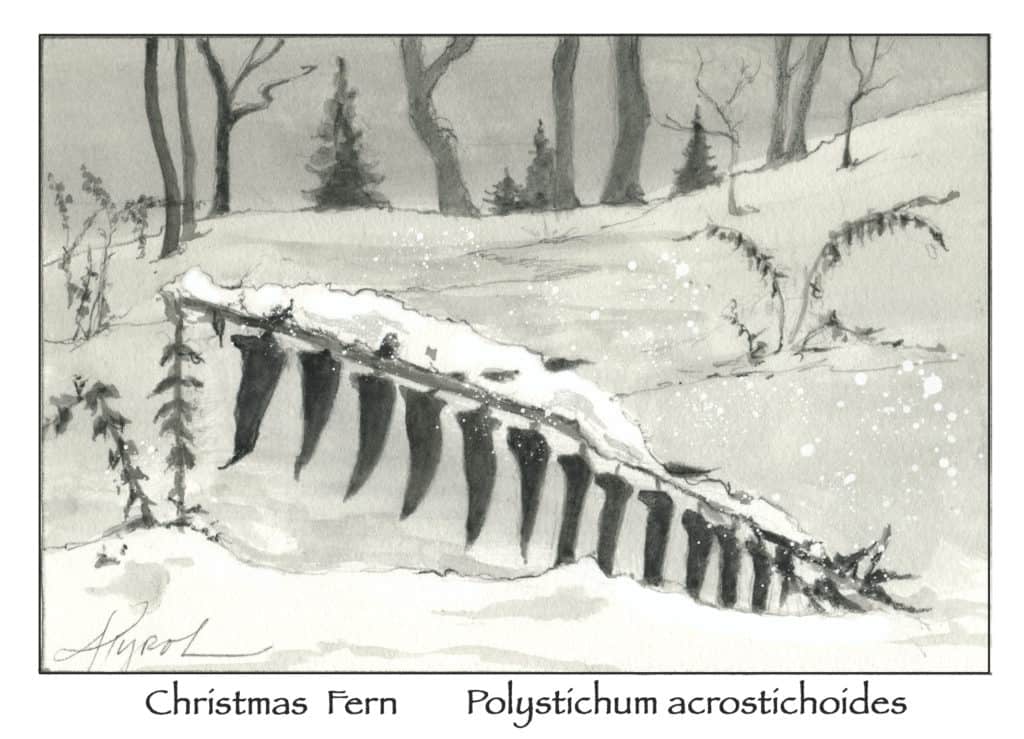
By Sandra Mitchell
Walking through the woods on a crisp December day, I spotted a flash of green amongst the rocks, snaking up through the snow. Greenery in a forest full of gray and white is a treat, and so I stooped to study the fern frond that was firmly attached to a rock.
In New England, there are four common evergreen ferns: rock polypody (Polypodium virginianum), Christmas fern (Polystichum acrostichoides), marginal wood fern (Dryopteris marginalis), and intermediate or evergreen wood fern (Dryopteris intermedia).
Clearly this was a fern, and there are only four common ones to choose from, but how to tell which fern was peeking up at me through the rocks? Some clear differences help identify these evergreen neighbors.
Rock polypody – the fern I was looking at – is a petite little fern, which grows in mat-like clusters on exposed rocky surfaces. Its leaflets are elongated, smooth-edged, and flared at the base where they meet the stem. In late spring and summer, if you find a patch of rock polypody and flip over the upper leaflets, you may find some spore cases – a sign that the plant is in reproductive mode. Often, however, they spread by rhizomes connecting the plants together. In fact, the Latin name (poly = many and pody = feet) refers to the many feet (roots) connecting one frond to the next. This beautiful little fern serves as winter food for animals such as deer, wild turkey, and ruffed grouse.
Christmas fern is much larger, growing up to 3 feet in height. This fern is known by many since it has been used as part of festive Christmas decorations since the early settlers arrived. It lives in forests and dislikes wet soil. One of its identification features is a “bump” or an “ear” at the base of each leaflet, near the stalk which many say looks like a miniature Christmas stocking. This beautiful fern is large enough to be visible through the snow and serves as habitat in the winter for small mammals and ground dwelling birds. Interestingly, it is toxic to deer, who will often choose to browse on all of the neighboring plants, leaving patches of Christmas fern alone.
Now we move on to the wood fern group, starting with marginal wood fern. This fern grows in rocky areas and lives in clusters, which look vase-like from a distance. Although the leaves are a bit lacier than those of the previous ferns, one of its most notable features is the unique, leathery, blue-green quality of its frond. Marginal wood fern gets its name from the fact that it produces spores on the edges (or margins) of the sub-leaflets, so in the late spring or summer when you turn over the leaves, you will see spores not in the center of the leaflet, but right at the edge. Every fern needs to find a way to be different, I suppose.
Our last common evergreen fern is the intermediate (or evergreen) wood fern. This beautiful fern has definitively lacy leaves and can be quite large – up to 3 feet tall. It lives in shaded, wet areas. Because it retains its beautiful green color so nicely and has such attractive fronds, it is commonly used in floral arrangements. Interestingly, however, this fern is able to secrete a toxic substance which can paralyze some cold-blooded animals and invertebrates.
This does not seem to reduce our enjoyment of it perched in the center of the dining room table, however.
On your next walk through the cold winter woods, keep an eye out for one of these lovely green reminders of spring.
Sandra Mitchell is an avid amateur naturalist, certified wildlife tracker, registered Maine guide, and a student in the Maine Master Naturalist Program. The illustration for this column was drawn by Adelaide Tyrol. The Outside Story is assigned and edited by Northern Woodlands magazine and sponsored by the Wellborn Ecology Fund of the New Hampshire Charitable Foundation.




